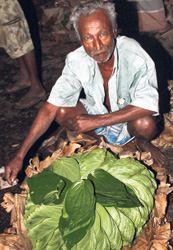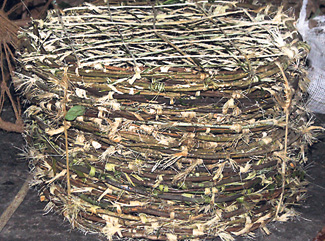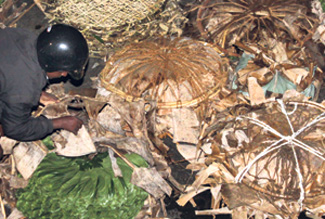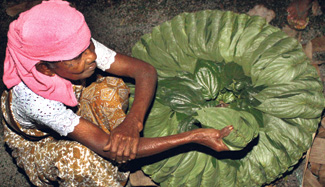With just a few days for the Avurudu, in the darkness of pre-dawn, betel growers and buyers wend their way to the ‘Bulath Pola’ in Alawwa town. By 4 a.m., the growers are ready with their produce awaiting the buyers who come from far and near to purchase the betel. Heads covered with towels to protect against the early morning chill, the vendors wait patiently beside their baskets of betel. The majority are older men, while there is a scattering of female vendors.
The use of betel leaf goes back a long way and it is said that it is mentioned in the ‘Mahavamsa’, the chronicle of Sri Lankan history. It plays an important part in local traditions and on auspicious occasions, such as the Sinhala and Tamil New Year.
A sheaf, containing 40 betel leaves is offered to elders and relatives as a mark of affection and respect. Students offer a sheaf of betel leaves to their teachers on the first day of school. Together with slivers of arecanut, a piece of tobacco and a pinch of slaked lime or chunam, many find it a relishing chew. Various medicinal properties are also attributed to the betel leaf, while there are several myths and superstitions associated with betel leaves.
The betel vine, with aromatic, heart-shaped, smooth green leaves, belongs to the pepper family. It originated in Malaysia and spread to most of Asia’s tropical region.
At the pola, we see the glossy green leaves arranged in concentric circles in shallow baskets lined with jute and covered with dried leaves to preserve the moisture. Premadasa has come from Halalpitiya with 2,500 leaves of bulath for sale. A buyer comes, picks up a bundle and flicks through it. Premadasa quotes Rs. 3,000 for 1000 leaves but the buyer goes on to the next vendor. Premadasa, who grows the betel in his garden, says he comes to the pola twice a month, bringing about 5,000 leaves at a time. The crop now is less because of the drought, he says.
Good soil, proper shade and irrigation are necessary for the successful cultivation of betel, farmers said. The soil needs to be constantly moist but not waterlogged. During the dry season the plants have to be regularly watered. This is why the crop is affected during the drought.
Haramanis, from Nelundeniya has frequented the Bulath Pola for the past 25 years. He comes once a week. Although he could harvest 5,000 leaves a week, he can only bring about 2,000, since plucking, sorting the damaged leaves, grading and arranging them takes time. He explained that in the betel creeper there are three grades of leaves. In the case of the smaller leaves known as ‘keti kola’, four leaves are counted as one.
 |
| Weekly visit to the pola: Haramanis with his stack of betel |
The next grade the ‘kanda kola’ requires two leaves to be counted as one. The best grade, the larger ‘peedichcha’ leaves are counted one for one. Although there are different varieties of betel most of the growers cultivate the common variety that is used for chewing. For export, ‘kalu bulath’ is grown, he said.
Squatting beside his basket of bulath was another longstanding vendor, Jayathilaka who comes from Nawathalwatta. He has been coming to the pola for the past 25 to 30 years. He had brought 1,600 leaves of the best grade for sale. He was waiting for a buyer who regularly purchases his leaves. M. H. Punchirala from Mahaarachchimulla, said he has come to the pola for the past 18 years, following his father who did the same before him. His children also help him to pluck and grade the leaves before the sale. He had 3,300 leaves for sale. The average price quoted by the vendors that day was Rs. 2,000 per thousand leaves.
The betel pola at Alawwa has been a long recognized market for betel. “Our elders tell us the pola has been going on at Alawwa for about 100 years,” said one vendor. The site has been moved a couple of times due to construction. Before, the Dambulla economic centre and other such centres came up elsewhere, the Alawwa pola had been the largest pola for many years. Apart from betel, there are also bananas, in one place and vegetables as well. Alawwa had been an important trading hub because of the convenience of transport to other areas in the country.
Nimal Wijesinghe is a regular buyer of betel from Alawwa, “I buy the second size of leaves,” he said. He takes the betel to Valachennai, Kalmunai and Monaragala. ‘I have orders from traders for 200,000 to 300,000 leaves regularly.
 |
| Neatly packed and below being sorted
after purchase. |
 |
However, they ask for arecanut and tobacco to go with the bulath chew so I buy these from vendors across the road.” On the road leading to the ‘bulath pola’, were several lorries loaded with sacks of arecanut. Piles of arecanut were also displayed on the road for inspection. Having purchased their requirement of betel leaves, many of the buyers buy the arecanuts also from these traders.
Having visited the bulath pola over 15 years ago, the Sunday Times found very little has changed. Time seems to have stood still at the Alawwa pola, with the vendors and buyers congregating and conducting their business in the same manner year after year. One difference we found was that there seemed to be fewer of the older women vendors.
Among the few female vendors was Malani Ranasinghe, from Niloluwa. She has started coming to the pola in recent years. She was offering 2000 leaves at Rs. 2000 per thousand.
“Betel is cultivated successfully in the area around Alawwa and Kurunegala,” said M.A. Gunasekera from Bogahawatte, eight miles away. A vendor for the past 15 years, he says the leaves are arranged in bundles of 40, which is known as a ‘bulath gonna’, while a sheaf of 20 leaves is a ‘bulath atha’.
The Alawwa bulath pola is managed by the Pradeshiya Sabha for the area, and is given out on tender. Dharmasena said he was from the group that won the tender. The tender include space for vegetables, bananas and arecanuts as well.
They keep their men posted at each site to collect the dues from the vendors. “The vendors pay us Rs. two for every thousand leaves they bring for sale,” Dharmasena said. “Betel from this pola goes out all over the country, including the north and east.” |





